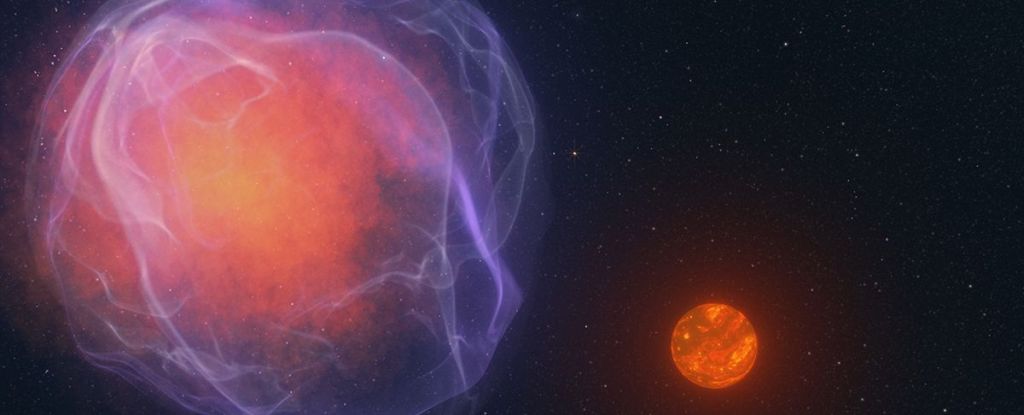Most of the stars in the Milky Way tread sedate and orderly orbital measures around the galactic center, but that’s not the case for everything. Every now and again a maverick is caught breaking ranks, whizzing along at speeds that will eventually see it punted clean out into intergalactic space.
These “hypervelocity” stars are extremely rare, but we’ve just spotted a particularly special example. A star named CWISE J124909+362116.0 (J1249+36 for short) not only exceeds the galactic escape velocity at around 600 kilometers (373 miles) per second, it’s a very rare type of tiny, ancient, main sequence star called an L subdwarf, which happens to also be one of the oldest in the Milky Way.
First spotted by citizen scientists combing through telescope data for signs of the mysterious Planet Nine, J1249+36 is one of just a handful of hypervelocity stars identified in the Milky Way – and although far from the fastest we’ve seen, it represents something of a challenge to astronomers; namely, how did it get so breathtakingly fast?
The discovery was announced at the 244th Meeting of the American Astronomical Society, with its paper recently submitted to The Astrophysical Journal Letters.
There are a number of possible explanations for the star’s velocity. The researchers explored three of them.
The first is expulsion from a binary system that includes a white dwarf star – the remnant core left behind when a Sun-like star runs out of hydrogen, ejects most of its outer material, dies, and enters its afterlife. Ultra-dense white dwarfs shine hotly with residual heat rather than fusion, and can be a bit unstable if they have a binary companion.
If the two stars are in a close orbit, the white dwarf can steal material from the companion star. The problem is that the white dwarf has an upper mass limit. If it gains just a bit of mass it can maintain its existence through repeated eruptions known as novae. However, if it gains too much mass, it will explode in a Type Ia supernova that completely obliterates the white dwarf.
“In this kind of supernova, the white dwarf is completely destroyed, so its companion is released and flies off at whatever orbital speed it was originally moving, plus a little bit of a kick from the supernova explosion as well,” says astrophysicist Adam Burgasser of the University of California San Diego.
frameborder=”0″ allow=”accelerometer; autoplay; clipboard-write; encrypted-media; gyroscope; picture-in-picture; web-share” referrerpolicy=”strict-origin-when-cross-origin” allowfullscreen>
“Our calculations show this scenario works. However, the white dwarf isn’t there anymore and the remnants of the explosion, which likely happened several million years ago, have already dissipated, so we don’t have definitive proof that this is its origin.”
The second possibility is a many-body interaction that becomes unstable and yeets one of the objects across the galaxy. There are environments within the Milky Way that make these interactions more likely, namely globular clusters – dense globs which can contain millions of stars. Thought to contain swarms of black holes at their centers, globular clusters have a higher-than-usual concentration of black hole binary pairs.
frameborder=”0″ allow=”accelerometer; autoplay; clipboard-write; encrypted-media; gyroscope; picture-in-picture; web-share” referrerpolicy=”strict-origin-when-cross-origin” allowfullscreen>
“When a star encounters a black hole binary, the complex dynamics of this three-body interaction can toss that star right out of the globular cluster,” says astrophysicist Kyle Kremer, of Caltech, shortly to join UC San Diego.
This, too, is plausible; but tracing the star’s trajectory backwards has not yet allowed the researchers to identify a specific globular cluster as its starting point.
The third option is that J1249+36 is not from the Milky Way at all, but one of the many satellite dwarf galaxies orbiting it. A 2017 study examining the provenance of hypervelocity stars found an extragalactic origin plausible. And the researchers’ calculations showed that it’s feasible for J1249+36, too.
All three options remain on the table. The best way to figure it out will be to examine the chemical composition of the star in greater detail. If J1249+36 was the companion of a white dwarf, the supernova could have left trace elements that polluted the L subdwarf’s atmosphere. Conversely, globular clusters contain stars that all have similar compositional properties, so it may be possible to link the star to a home population that way.
And if neither of those pan out, we may need to look to the Milky Way’s satellites, to determine whether this tiny, dim star is a stranger from outside the galaxy, just winking howdy as it passes through.
The discovery was presented at the 224th Meeting of the American Astronomical Society.





